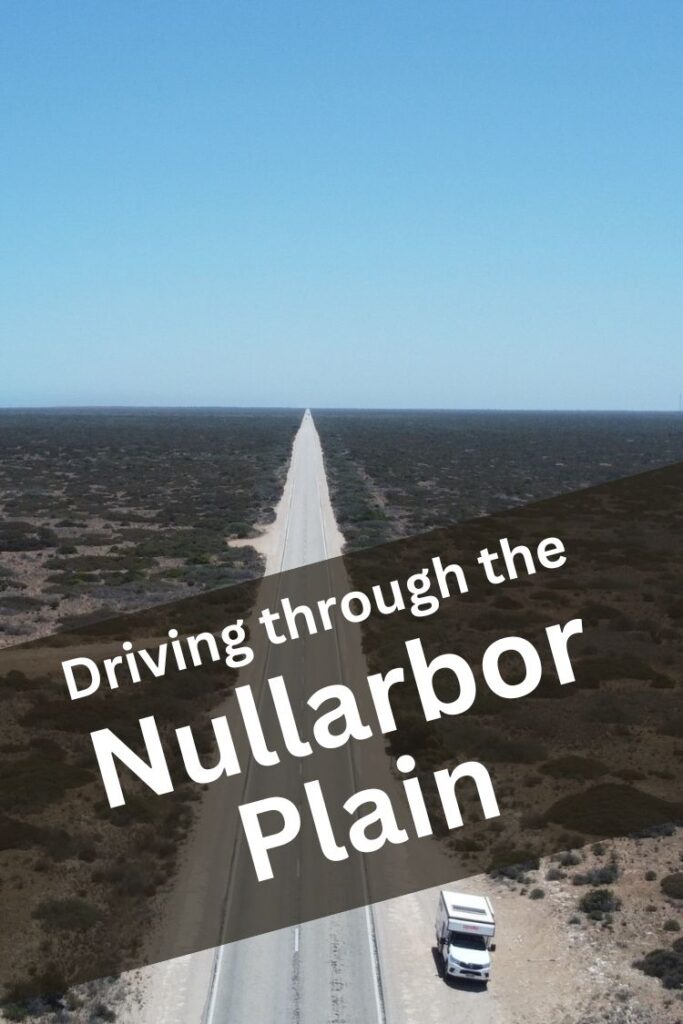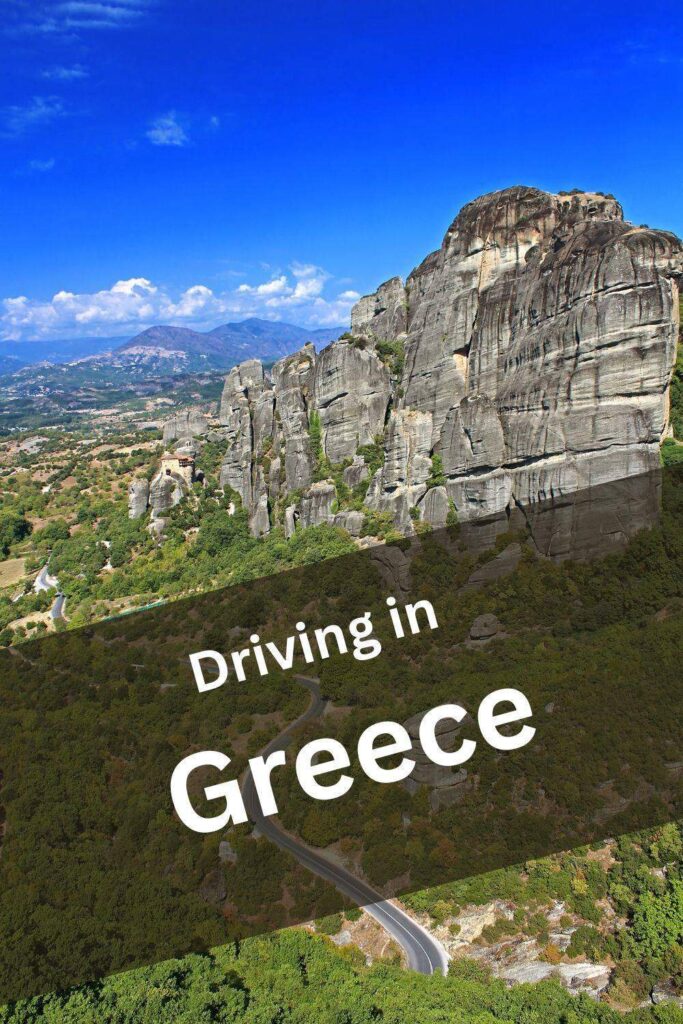This is a journey of great experiences on the largest of the Hawaiian islands. The Big Island, called Hawai'i and giving the name to the entire archipelago, hosts incredibly diverse environments and landscapes. From the rugged and wild terrain of the volcano region to the lush tropical rainforests of the north and east to the warm beaches of the west. Getting a car and exploring the island was a constant discovery of entire small pockets of ecosystems, all packed on this volcano in the middle of the Pacific Ocean.
For many, the islands of Hawai’i are synonymous with a paradise getaway destination. An escapist dream, separated from the rest of the world.
The fact that luaus, alohas, mahalos, and shakas have become common words is a testament to how much influence these small, secluded islands in the Pacific have had on our popular culture.
The archipelago comprises eight major islands and dozens of smaller ones. The most famous ones are Maui, O’ahu, Molokaʻi, Lānaʻi as well as Hawai’i itself – the Big Island.

What to expect
- Rainforests with ferns the size of trucks, straight of out Jurassic Park movies
- One of the best astronomical observation sites on top of Mauna Kea
- Black-sand beaches
- Pristine waters and marine life
- Relaxed and chill people and atmosphere
- One of the best surfing spots in the world
Tips & Impressions
- People and tourism: It is no secret that native Hawaiians don’t like foreigners or Haoles, but it is mostly referred to those who settle there. From a tourism point of view, being much of the island’s income, the friendliness is immense. Think of chill US Americans, which should give you an idea. The east side of Hilo, which is much less touristic and basically a big residential area, is harder for tourists to get around as shops, restaurants, etc. outside of the main city are almost nonexistent.
- Friendliness: Jordanians are very friendly. Amongst each other, they will go out of their way to display affection and greetings. Towards visitors, they will often smile, wave, try to help, or start a conversation.
- Connectivity: Excellent. While browsing and searching for hotels, I saw that every hotel would boast good connectivity and internet speed, and now I understand why.
Overview
At first, the concept of a road trip in Hawaii may seem strange and not many people visit these beautiful islands this way. But having just been to Fiji, where I spent time relaxing in resorts by the beach, I was keen on exploring the next destination. So instead of staying on one of the smaller, arguably more relaxing and beach-oriented islands, I moved to the Big Island and rented a small car to explore the surroundings.
I split my stay between the rainforest-filled eastern side, in the town of Hilo, and the western town of Kailua Kona, driving a couple of hours each day from my apartment base to see the many wonders that the island has to offer.
See the Itinerary below for a detailed breakdown on every location
Country Info
- Language: English is the official language and the most commonly spoken.
- Population: 328+ million (2019)
- Timezone: [UTC -10, UTC -5]
- Ethnic Make-up: White American (72.4%), African American (12.6%), Native American (0.9%), Asian American (4.8%) (2010 Census)
- Religion: 70-78% Christian
- Political System: Constitution-based federal republic
- Currency: US Dollar (USD)
- Credit Cards: Almost anything can be paid with credit cards and ATMs are extremely common.
- Electricity: Socket Type A and B (“US” style..doh), 120±6 volt / 60 hertz.
- Tipping Customs: 15-20%
- Haggling Culture: Not common
Safety
- Safety: Despite being a US state, violent crime is quite rare on the islands and crime goes as far as pickpocketing or drug-related.
- Natural risks: When it comes to safety in Hawaii, it is more a matter of natural risks. In Hawaii, there are five volcanoes, four of which reside on the Big Island and these are all active to this day. Because of this, the major potential risks are volcanic-related events such as earthquakes and tsunamis.
- Emergencies number: 911
Getting around
- Driving: I was surprised by the number of cars and somehow expected a higher amount of slower mobility. Driving around naturally requires having a chill attitude, also known as driving with aloha. Driving etiquette is something between the US and what would be expected on a chilled-out island. I was actually harshly reprimanded by a driver for apparently being too close and tailing him; he was about to get out of the car and called me three different names in one single sentence. After driving around for a while, the signature shaka gesture becomes second nature to thank other drivers instead of the typical wave or palm of the hand.
- Roads: There are many roads in residential areas which are exclusive to residents so to limit traffic. The main roads are few, as expected but in perfect condition, and the unpaved roads are in good shape and have clear road signs everywhere.
Weather
Generally speaking, the weather in Hawaii is hot and humid, with frequent rainfall. However, given the isolation of the island, the wet and hurricane seasons do not affect Hawaii that much, leaving the weather relatively tame.
Given its proximity to the equator, sunblock is a must, but not all places are hot and sunny. The islands are all volcanic and there can be a large difference in elevation, with consequent temperature differences. On the Big Island in particular, the summits of Mauna Kea and Mauna Loa often experience snowfall and the temperature can easily drop to freezing.
I was quite shocked by the difference between the east and west coasts of the island. The whole east coast surrounding Hilo was perpetually covered in rain, beating down on the molten magmatic rocks. Once climbed over Mauna Loa and traversed to the other side, the weather changed completely, transforming into the more expected sunny and dry climate, with all the clouds kept at bay by the imposing mountain.
Flora & Fauna
This is probably the most striking aspect. The island is basically split in half by the Mauna Loa volcano, which divides the microclimates on the island. The east is covered in rainforests, whereas the west has beaches. This creates a nice balance regarding the “static” natural wonders, with the east side showcasing volcanoes, rainforests, and rainbows, whereas the east side offers black sand beaches, incredible sunsets, and numerous animal species in their environment.
When it comes to wildlife, in Hawaii there are no predators and the fauna is generally harmless. That being said, the island in the middle of the Pacific has some marine species that, much like in Australia, are very dangerous, such as the infamous Box Jellyfish, Cone Snails, Moray Eels, Tigers, and Great White Sharks.
On land, the rainforests create a natural habitat for spiders and snakes, some of which are venomous.
The natural attraction and diverse fauna lie in the ocean. Snorkeling and diving areas are beautiful and apart from the famously high presence of turtles, the coral reef is pristine and wonderful to explore.
Etiquette
- As in all other places, do not take anything from the island with you. When it comes to nature, such as lava rocks, sea shells, or plumage, it is frowned upon, and there is a belief in Pele’s Curse, stating that removing anything natively Hawaiian will bring bad luck to whoever takes it away. Besides, it is actually illegal to remove minerals in Hawaii.
- Do not disturb the wildlife such as sea turtles or other animals and respect their natural habitat.
- In Hawaii, friendliness is the way to go. You will hear extensively about aloha and mahalo and these greetings and thank-yous should be reciprocated.
- It is common to witness hulas. These dances are everywhere for visitors to enjoy but are an important part of Hawaiian culture. As such, do not make fun of the dancers or join the hula uninvited.
- Hawaii inherits the Asian Pacific tradition of taking shoes off in other people’s homes.
Deals for Hawai’i
Itinerary
Trip Stops
Hilo
Hilo

About
Despite being the largest city on the Big Island in terms of area, Hilo has a small population and is much less frequented by tourists.
It lies on the eastern side of the island, where the tropical microclimate makes it incredibly humid. The town of Hilo is actually the second rainiest town in the United States (outside of Alaska).
This heavy rainfall benefits the surrounding fauna creating some of the most impressive rainforests ever in terms of the size of the plants that inhabit it.
Impressions
The town of Hilo does not have a lot to offer to visitors and is mostly for locals and residents, although there are some historical and very nice cafes as well as several shops for surfing gear located in Hilo Bay.
It is a good location for setting up base in a hotel or apartment being close to the Volcano region and lush rainforests nearby.
Within an hour’s drive of my apartment, there are probably 10 restaurants, all of which are either these disgusting taco bells, McDonald’s, et al. inside huge parking lots, or beaten-up shacks where “Frankie” can cook you a pizza near a gas station if you can wait for 30 minutes and can stomach it.
AccommodationI stayed in a studio apartment in the residential area near the town of Hilo. Not much to say here, as the area is quite boring and I needed it only as a base for quickly visiting the nearby Volcano region.
Deals for Hilo
‘Akaka Falls State Park
‘ Akaka Falls

About
Akaka Falls is a 135mt high waterfall located within the ʻAkaka Falls State Park.
The accessible portion of the park lies high on the right shoulder of the deep gorge into which the waterfall plunges and the falls can be viewed from several points along a loop trail through the park.
Drive
25 kms from Hilo
Impressions
The park is a short circular walk within the huge forest. Huge from the point of view of the sheer size of the surrounding vegetation. The largest ferns I have ever seen are as big as cars. Bamboo trees are as tall as entire houses. It all felt very “Jurassic Park” (which has all been filmed basically somewhere on the Hawaiian Islands, and now I see why).
Rainbow Falls & Boiling Pots
Wailuku River State Park
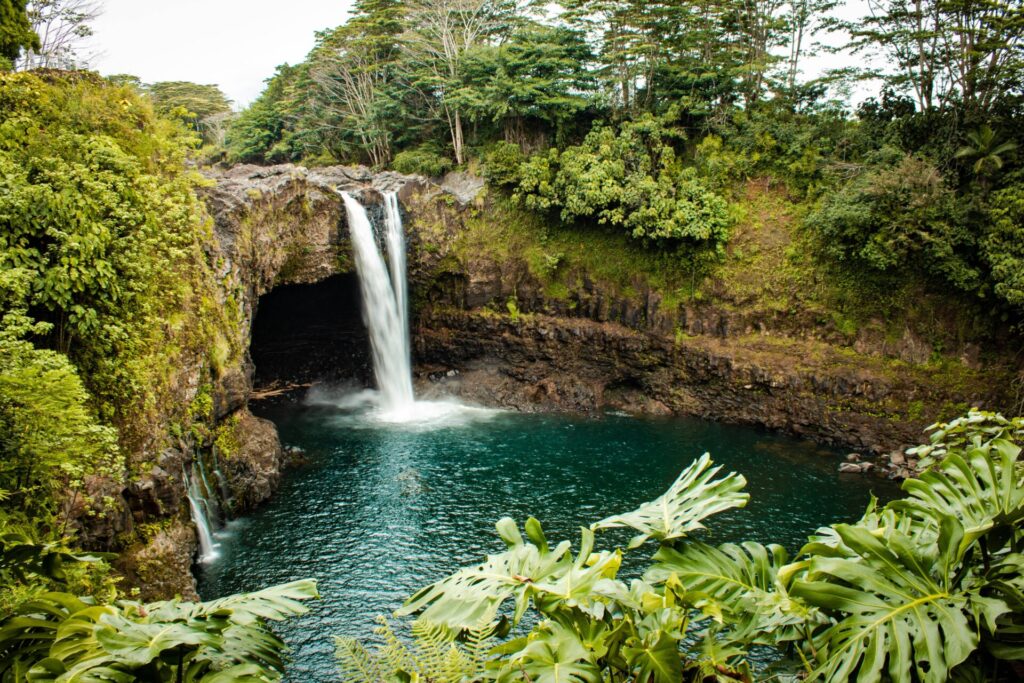
About
Rainbow Falls are a 24-meter tall and 30m wide waterfall fed by the Wailuku River.
Known in the Hawaiian language as Waiānuenue (literally “rainbow water”), the falls flow over a natural lava cave, the mythological home of Hina, an ancient Hawaiian goddess.
Drive
3 kms from the city center of Hilo.
Impressions
Close to the ‘Akaka Falls are the Rainbow Falls, which often portray rainbows within the mist but, due to the weather, I was not able to see. As with other similar falling waterfalls, you can see the optical illusion of the surrounding rocks moving (if you stare still at a point of the waterfall, which you can’t and your eyes will constantly skim up, for 10–15 seconds, the surrounding cliffs will start to move upwards). Always a neat illusion.
Kaumana Lava Cave
Kaumana Lava Cave
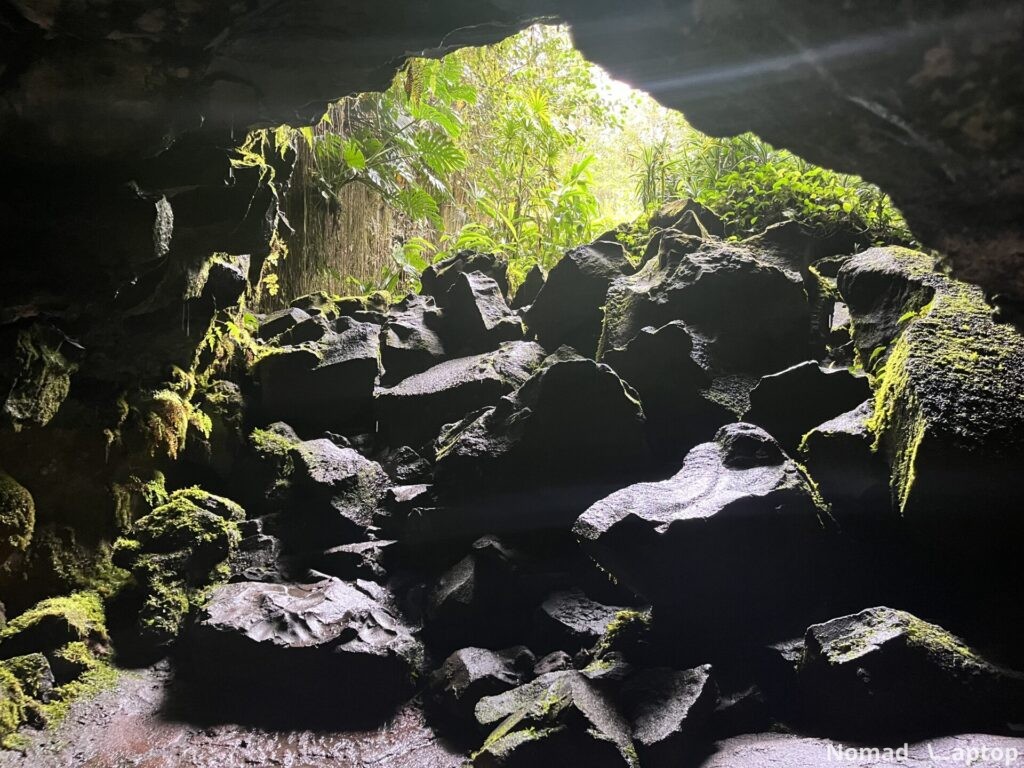
About
The Kaumana Cave is a lava tube created by a lava flow from Mauna Loa occurred in 1881.
Located near Hilo stands the immense tube is more than 2km long making it the 57th longest lava tube in the world.
Drive
7 km from Hilo
Impressions
The lava caves were amazing. I enjoyed that there were no lights, no walkways, or any other sort of comfort for the visiting tourists. Instead, the whole tunnel was in pitch darkness. The surrounding walls, ceiling, and floor, all covered in petrified magma, gave that otherworldly vibe to the whole exploration. Also, the absolute silence was immense and the intermitting dripping of water was deafening.
Punalu’u black sand beach
Punalu’u

About
Punualu’u, also known as Black Sand Beach, despite not being the only black sand beach on the island, is famous for the green turtles that bask on the black sand.
Drive
Punalu’u is on the southern part of the island, 90 km from Hilo.
Impressions
I skipped lunch (I didn’t really have a choice since the whole central area of the island is void of any town, shop, restaurant, cafe, etc.) and proceeded south towards Punalu’u Black Beach (I mean African American Beach).
One thing that struck me, apart from the obvious unusual sand color, is the consistency of the beach. I still don’t know whether it was a small earthquake or the composition of the sand, but walking on the less-beaten, compacted parts of the beach gives a strange feeling of instability. The sand “trembles” under your feet so to speak.
The beach is famous and was pretty busy (a poor green turtle had more tourists taking pictures of it, including me, than a movie star on the red carpet at the Oscars). I managed to find a spot and admire the scenery. I enjoyed watching the complexity of the shoreline and the effects it had on the crashing waves. I spent a while there just getting burned by the sun while imagining tales of angry Nāmaka.
Kīlauea
Kīlauea
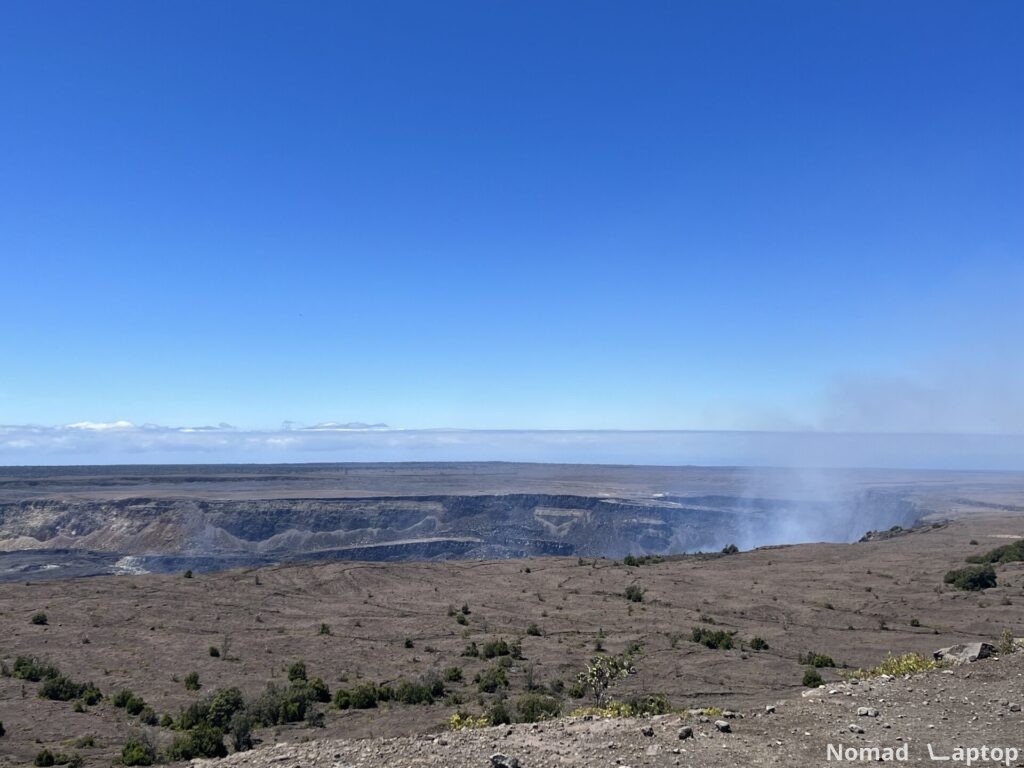
About
Kilauea is the most active of the five volcanoes that together form Hawaii Island and is one of the most active volcanoes on Earth.
Originally, it was considered only a satellite of its much larger neighbor, Mauna Loa, but is now recognized as an independent volcano.
In Hawaiian mythology, the Halemaʻumaʻu crater of Kīlauea is the home and also a physical representation of the goddess of fire, lightning, and wind, Pele.
Drive
Kilauea is within the Volcano region, 50 km inland from Hilo.
Impressions
The island of Hawai’i is formed by 5 flat shield volcanoes, 3 of which are dormant or extinct, the other 2 being Kilauea and the larger nearby Mauna Loa, both of which are still active and contributing to the creation and extension of the island to this day.
The Halema’uma’u crater of Kilauea is one of Earth’s most active volcanoes and in Hawaiian religion and mythology, it is the home of the deity Pele. According to some versions of the legend, she fled to Hawaii to escape the rage of her sister Nāmaka, goddess of the seas, because she stole Nāmaka’s sorcerer husband and found refuge on the tall mountain of Mauna Loa, where the crashing waves of her enraged sister would not reach her. To this day, the lava flows meeting the sea are seen as an everlasting conflict between the two siblings. According to other tales, she was killed by Nāmaka and her pissed-off spirit embodies itself through the lava and steam emitted from Kilauea.
After taking some pictures from lookout points, I took a long hike through the Devastation Trail and Kilauea Trail, which coasted the crater, through the surrounding forest, and descended into the caldera. The trails were spotted with steam vents, which I quickly passed by due to the unbearable heat (as well as sulfur and carbon monoxide exhalations).
Due to its ongoing activity, it is not possible to actually visit the Halema’uma’u Crater, and most of the surrounding flat caldera is off-limits. However, the little section that I was able to traverse was otherworldly, as the rocks on the ground felt both completely compressed and immovable and brittle at the same time. The searing sunrays and vapors on the horizon helped create this hellish perception of the environment.
Kaimū black sand beach
Kaimū
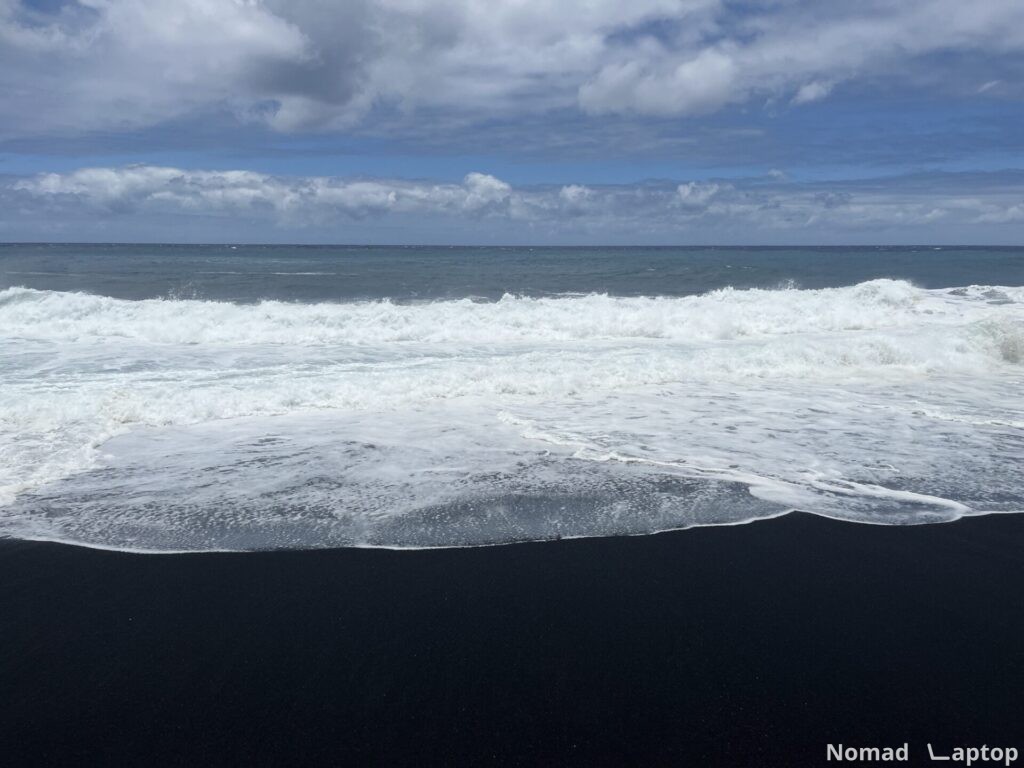
About
Kaimu Beach is near the village of Kalapana, on the eastern side of the island. The village itself was submerged by lava from Kilauea in 2010 and 2018.
Drive
The village of Kalapana and Kaimu Beach are on the southwestern part of the island, 45 km from Hilo.
Impressions
Kaimu Beach gave me a similar feeling to my visit to Kilauea. The vast stretch of solidified volcanic rocks which lead to the coast, with burned and abandoned cars and timid plants desperately poking from the ground was an otherworldly scene.
As nice as the beach is, it is arguably impossible to swim on due to the strong waves crashing on the shore. Even more than Punalu’u, it really felt like witnessing the goddess Nāmaka throwing tantrums at the volcanic coastal rocks.
Kailua Kona
Kailua Kona
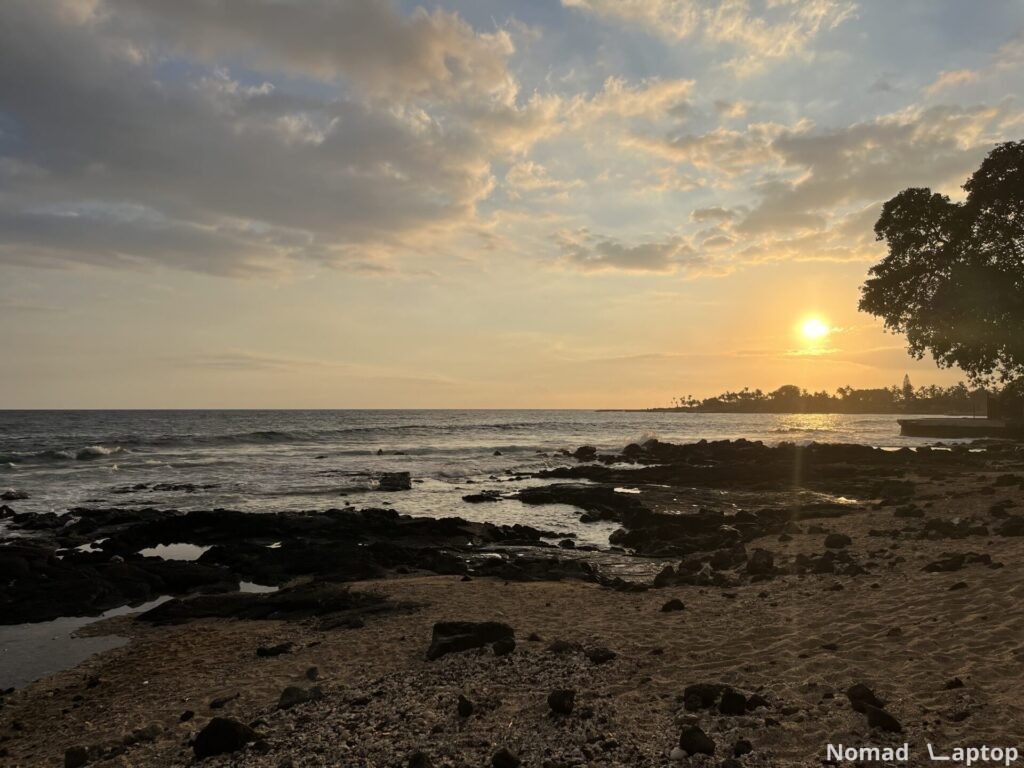
About
Nestled at the bottom of Mount Hualalai on the south-western coast of the island, the small town of Kailua Kona (also known simply as Kona) is more famous and frequented by tourists than the larger Hilo. This is because its weather is completely opposite to Hilo’s, with the mountains behind the town blocking the winds and sheltering Kona from the rain, making the town enjoy more than 300 days of sunshine a year.
Home to the famous King Kamehameha I, who united the Hawaiian Islands, the once-fishing village boasts excellent weather and is known today for its snorkeling and beautiful sunsets.
Drive
Kona is on the direct opposite side of the island with respect to Hilo, 125 km away. The drive is around 3 hours because of the need to climb up the immense Mauna Loa mountain.
Impressions
I moved to the west side of the island and it has been like moving to a whole different continent. The immense Mauna Loa volcano, which basically composes more than half of the island and is the largest volcano on Earth, separates the two sides of Hawaii.
The east side, with its tropical rainforest climate and ever-present rain, started grinding on me. The west side, on the other hand, is the more arid, beach, snorkeling, and tourist side. I already knew this but I did not expect the difference to be so extreme. The town of Kailua Kona is like Honolulu: too much tourism, too many shops, and too many bars on the coast with happy hour and fake luaus exhibitions. But after 10 days of “real” West Side, I will gladly take it. Today was the first day I had been able to see a sunset, and I could see the rain-filled clouds gather over the towering mountain without invading the city like it would happen every morning, day, and night on the east side.
Accommodation
I stayed in an apartment at Kona Islander Inn Condos ($$$$$), facing the coastal road and nearby all the cafes and restaurants where I could enjoy the evening sunsets, drinks and luaus.

Deals for Kailua Kona
2 Step
Kealakekua

About
Kealakekua Bay offers some of the best snorkeling and diving in Hawaii due to its shallow waters and lack of strong waves or tides, in contrast to other parts of the island’s coast.
The site is famous also for it being the place of death of Captain Cook. After an initial peaceful encounter with the ancient Hawaiians, relations started to sour because of a series of misunderstandings and acts of disrespect, and ultimately found himself and his crew outnumbered during their retreat.
Drive
30 km from Kona to reach the start of the 2.8 km trail.
Impressions
There is an arguably hard trail leading to the bay. I did not take any sunscreen or water. The 2.8-kilometer hike was in fact quite difficult due to the vegetation and the last parts descending the volcano under the scorching sun, but from what I had read, it seemed like the most arduous hike in the world. Reviews would warn against extreme dehydration, the necessity for the best climbing gear shoes, etc. All I can say is that it was a hike. 1.5 hours at my quick pace.
When I reached the sea, I was confronted with something like 50 snorkelers, all bumping into each other, each with their own fluorescent floating device. There are 3 ways to reach the spot: swimming from the other side of the bay, through this arguably difficult hike, and by boat. I arrived when four boats had just arrived and had thrown their anchors and their dozen snorkelers each. I walked to the side of the main area, did a part into the jungle/forest and found a nice quiet spot.
Finally! After having traveled around half of the world, I had a decent reef experience that reminded me of when I was a kid in the Red Sea: floating in the shallow water only to be dragged around by the current with dozens of colorful fish all around was both peaceful and exciting. I saw hundreds of sea urchins, finally some healthy corals, hundreds upon hundreds of yellow fish, and some other multicolored ones interspersed here and there. When I swam further out and reached the cliff to the deeper ocean, I found myself surrounded by needlefish, all of them calm, just being dragged by the current and occasionally diving deeper to take a bite at something within the corals. Generally, all the “classical” reef fish, of which I do not know the names,
I spent a couple of hours on the boiling volcanic stone slabs that fall into the ocean, near a submerged plaque indicating the death spot of James Cook, observing the crabs and the numerous yellow fish on the surface, which could be seen with the naked eye. The water was clear and at the perfect temperature. I did a couple of immersions, and every time I would come out (with quite some difficulty due to the slippery algae and tons of sea urchins all around), I would see a bunch of curious mongooses snooping around my backpack.
Closing thoughts
The island of Hawai’i is everything that I had expected. It is more rugged than other arguably prettier Hawaiian islands and I enjoyed the lack of immense resorts or pristine beaches in favor of a wilder and more genuine natural environment.
Despite being stricken by some bad luck with the flu for a couple of days, the closure of the famous Waipio Valley, and especially the weather conditions that prevented me from going to the top of Mauna Loa for astronomical observations and seeing the surrounding volcanoes, the stay was wonderful nonetheless and the island is really a small little paradise protruding from the Pacific Ocean.

